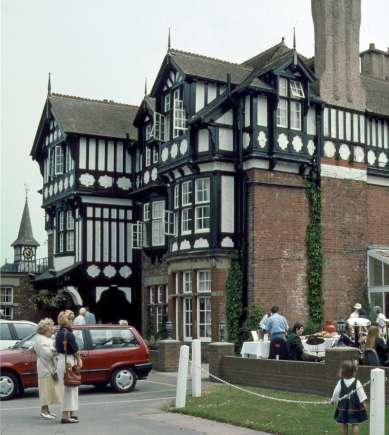Alvaston Hall Beam Heath Nantwich
In the early 1800's Alvaston Hall was known as “The Grove,” and was owned by Croudson Tunstall, a Quaker banker and farmer. It was bought and rebuilt by Frances Massey. In 1896 Arthur Knowles, a wealthy Manchester industrialist who had been involved with the Cheshire Hunt for many years, bought “The Grove,” and transformed it into a grand country house. It was renamed Alvaston Hall and Mr and Mrs Knowles soon turned it into a centre of Cheshire social life.
The design of the alterations and additions to the hall was by Salomons and Steinthal, who “practically rebuilt” the house according to The Builder. They certainly added a new third floor, “in solid sunken construction filled in with brick and cemented with spa facing” and the great projecting porch with gargoyle rain heads. Inside, the house was transformed with Elizabethan panelling and ornate plaster ceilings. Lit by a large stained glass window, the magnificent great hall was used as the main living room. This double height space featured a timber ceiling and oak panelled dado and frieze. The large fireplace had Italian ironwork while the balustrades to the stair and landing show Japanese influence. The dining room was panelled in dark stained oak. In the chimney piece was a painting by Hoppner, the frame designed with the rest of the work. The drawing room was panelled up to the frieze and painted white. All doors were of dark mahogany with specially designed bronze furniture and hinges. The ceilings to the dining room, drawing room and boudoir were of plaster, specially carried out by Hindshaw of Manchester to the designs of Mr Cooper. Originally opening off the ladies’ white panelled drawing room, the billiard room was finished in Cyprus wood stained a greenish tone. Panels in the plaster frieze illustrated sporting subjects, again modelled by Mr Cooper. This, together with the original conservatory, has been demolished. Reconstruction work, estimated to have cost £16,000, was not quite complete in April 1897 when the house was illustrated in The Builder.
Arthur Knowles spent much of his considerable fortune on Alvaston. The grounds contained a cricket pitch, tennis courts and a barn-like building that contained one of the first electric power systems in England. A new large stable block with a pretty clock tower was added to the north, while a lodge was built at the entrance. These grounds were contained by a “ha-ha,” and the present drive was planted with lime trees on either side to give the approaching visitor tantalising glimpses of the hall. The stables housed his private string of race, carriage and hunting horses. He was particularly interested in the breeding of bloodstock for racing and his racehorses won many sporting events. One of his horses, “Jack Ta”, was so successful that one night he was stolen from his stable: the thieves covering his hooves with velvet to muffle the sound of his abduction. After a frantic search in which every post Office in England was kept open and every policeman in Cheshire was on full alert, the horse was found abandoned in Holmes Chapel - too late for the race.
After an afternoon at Haydock Park races in 1929, Arthur Knowles fell ill and died. He was given a simple funeral, his coffin carried on a farm waggon to Wistaston Church where he was buried beside his wife who had died tragically in 1913. The “Goliath of the Manchester Coalfield” was no more and his business had already begun to decline among the first rumblings of the depression. Alvaston Hall and its contents were auctioned in 1930.
After a succession of private owners, the Hall was converted into a hotel in 1964. In 1972 the hotel was purchased with only ten lettable bedrooms. Conversion of the Victorian servants’ quarters, the stables, coach house engine and harness rooms began, increasing the accommodation to 90 rooms. In 1980 the south wing was added with 18 more rooms.
